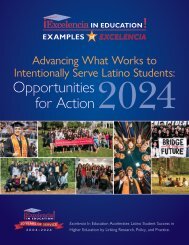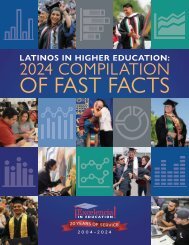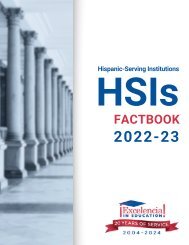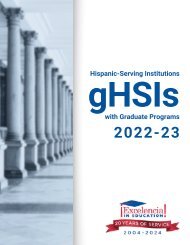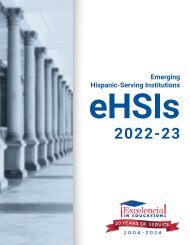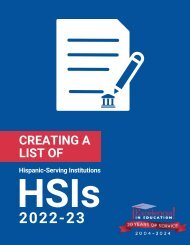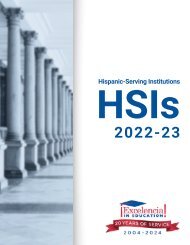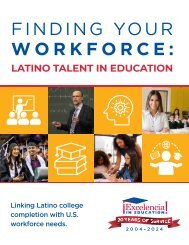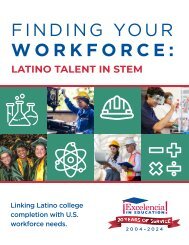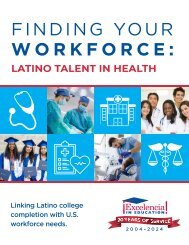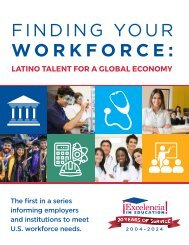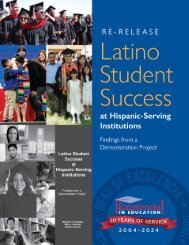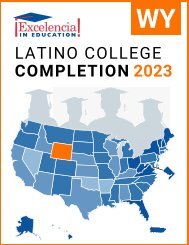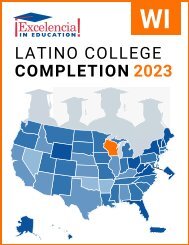Latino College Completion 2023: New Hampshire
Create successful ePaper yourself
Turn your PDF publications into a flip-book with our unique Google optimized e-Paper software.
NH
LATINO COLLEGE COMPLETION:<br />
NEW HAMPSHIRE – <strong>2023</strong><br />
For the U.S. to regain the top ranking in the world for college degree<br />
attainment, <strong>Latino</strong>s will need to earn 6.2 million degrees by 2030. 1<br />
FAST FACTS<br />
STATE RANKING:<br />
<strong>New</strong> <strong>Hampshire</strong> had the 43rd largest<br />
<strong>Latino</strong> population in the U.S.<br />
K-12 POPULATION:<br />
In <strong>New</strong> <strong>Hampshire</strong>, 7% of the K-12<br />
population was <strong>Latino</strong>. 2<br />
POPULATION:<br />
In <strong>New</strong> <strong>Hampshire</strong>, 4% of the<br />
population was <strong>Latino</strong>. 2<br />
MEDIAN AGE:<br />
The median age<br />
of Hispanics in<br />
<strong>New</strong> <strong>Hampshire</strong><br />
was 29, compared<br />
to 45 for White<br />
non-Hispanics. 2<br />
29<br />
Hispanics<br />
45<br />
White<br />
non-Hispanics<br />
ENROLLMENT:<br />
In <strong>New</strong> <strong>Hampshire</strong>, 22% of<br />
Hispanics (ages 18 to 34) were<br />
enrolled in higher education, compared<br />
to 22% of White non-Hispanics. 2<br />
DEGREE ATTAINMENT:<br />
In <strong>New</strong> <strong>Hampshire</strong>, 41% of Hispanic<br />
adults (25 and older) had earned an<br />
associate degree or higher, compared to<br />
50% of White non-Hispanic adults. 2<br />
Hispanic Adults = 4.1 of 10<br />
To reach the degree attainment goal by 2030, the U.S. can: close<br />
the degree completion gap by accelerating <strong>Latino</strong> completion while<br />
increasing for all students and scale up programs and initiatives that<br />
work for <strong>Latino</strong>, and all, students. The following demographics,<br />
institutional data, and practices inform <strong>Latino</strong> degree attainment.<br />
ENROLLING: Top 5 Institutions (Hispanic Undergraduates) in <strong>New</strong> <strong>Hampshire</strong>, 2021-22<br />
Institution<br />
Sector<br />
Grand<br />
Total<br />
NOTE: We use the terms <strong>Latino</strong> and Hispanic interchangeably in this factsheet.<br />
Hispanic<br />
Total<br />
Source: Excelencia in Education analysis using U.S. Department of Education, National Center for<br />
Education Statistics (NCES), Integrated Postsecondary Education Data System (IPEDS), 2021 Fall<br />
Enrollment, Graduation Rates Survey and Institutional Characteristics Survey.<br />
%<br />
Hispanic<br />
Private not-forprofit,<br />
4-year<br />
1 Southern <strong>New</strong> <strong>Hampshire</strong> University<br />
119,248 12,982 11%<br />
Private not-forprofit,<br />
4-year<br />
2 Dartmouth <strong>College</strong><br />
4,533 453 10%<br />
3 University of <strong>New</strong> <strong>Hampshire</strong>-Main Campus Public, 4-year 11,429 448 4%<br />
4 Nashua Community <strong>College</strong> Public, 2-year 1,033 218 21%<br />
5 Manchester Community <strong>College</strong> Public, 2-year 1,887 187 10%<br />
ASSOCIATE DEGREES: Top 5 Institutions Awarding to Hispanics in <strong>New</strong> <strong>Hampshire</strong>, 2020-21<br />
Institution<br />
Sector<br />
Grand<br />
Total<br />
Hispanic<br />
Total<br />
%<br />
Hispanic<br />
Private not-forprofit,<br />
4-year<br />
1 Southern <strong>New</strong> <strong>Hampshire</strong> University<br />
3,227 376 12%<br />
2 NHTI-Concord’s Community <strong>College</strong> Public, 2-year 486 22 5%<br />
3 Manchester Community <strong>College</strong> Public, 2-year 301 19 6%<br />
4 Nashua Community <strong>College</strong> Public, 2-year 226 18 8%<br />
5 Great Bay Community <strong>College</strong> Public, 2-year 246 9 4%<br />
BACHELOR DEGREES: Top 5 Institutions Awarding to Hispanics in <strong>New</strong> <strong>Hampshire</strong>, 2020-21<br />
Institution<br />
Sector<br />
Grand<br />
Total<br />
Hispanic<br />
Total<br />
%<br />
Hispanic<br />
Private not-forprofit,<br />
4-year<br />
1 Southern <strong>New</strong> <strong>Hampshire</strong> University<br />
15,584 1,561 10%<br />
Private not-forprofit,<br />
4-year<br />
2 Dartmouth <strong>College</strong><br />
1,150 116 10%<br />
3 University of <strong>New</strong> <strong>Hampshire</strong>-Main Campus Public, 4-year 2,911 74 3%<br />
4 Keene State <strong>College</strong> Public, 4-year 706 35 5%<br />
Private not-forprofit,<br />
4-year<br />
5 <strong>New</strong> England <strong>College</strong><br />
327 22 7%<br />
White Adults = 5.0 of 10<br />
1 Projections to 2030: Excelencia in Education. (2020). Ensuring America’s Future: Benchmarking <strong>Latino</strong><br />
<strong>College</strong> <strong>Completion</strong> to 2030. Excelencia in Education. Washington, D.C.<br />
2 U.S. Census Bureau, 2021 American Community Survey 1-Year Estimates
<strong>New</strong> <strong>Hampshire</strong> Gap in Degree <strong>Completion</strong><br />
Closing the degree completion gap can be tracked<br />
by the 4 measures shown below. Alone, none<br />
of these measures capture the entire “story” of<br />
degree completion. However, in combination,<br />
they provide a useful picture of the gap in degree<br />
attainment between Hispanic and White non-<br />
Hispanic cohorts in a single year.<br />
Graduation Rate — Total percentage of students<br />
who graduated within 150% of normal time for<br />
first-time, full-time freshmen. This incorporates<br />
students that graduated in 3 years at two-year<br />
institutions, or in 6 years at four-year institutions.<br />
Transferred to Another Institution —<br />
Percentage of students that transferred to another<br />
institution and did not complete a degree.<br />
Still Enrolled — Percentage of students that are<br />
still enrolled at the point of 150% normal time to<br />
completion.<br />
No Longer Enrolled — Percentage of students<br />
that are no longer enrolled at the point of 150%<br />
normal time to completion.<br />
At two-year institutions, Hispanics’<br />
graduation rate was 9%-points<br />
lower than that of their White non-<br />
Hispanic peers in <strong>New</strong> <strong>Hampshire</strong>.<br />
TWO-YEAR INSTITUTIONS<br />
37%<br />
9%<br />
21%<br />
33%<br />
WHITE<br />
-9%<br />
37%<br />
16%<br />
22%<br />
24%<br />
HISPANIC<br />
DEGREE OUTCOMES<br />
■ No Longer Enrolled<br />
■ Still Enrolled<br />
■ Transferred to<br />
Another Institution<br />
■ Graduation Rate<br />
*Percentages may not add up to 100% due to rounding.<br />
At four-year institutions, Hispanics’<br />
graduation rate was 18%-points<br />
lower than that of their White<br />
non-Hispanic peers in <strong>New</strong><br />
<strong>Hampshire</strong>.<br />
FOUR-YEAR INSTITUTIONS<br />
1%<br />
31%<br />
64%<br />
WHITE<br />
-18%<br />
40%<br />
46%<br />
HISPANIC<br />
NOTE: Outcomes shown are for students at two-year institutions who started in Fall 2018, and<br />
for students at four-year institutions who started in Fall 2015.<br />
Source: Excelencia in Education analysis using the U.S. Department of Education, National<br />
Center for Education Statistics (NCES), Integrated Postsecondary Education Data System, 2021<br />
Graduation Rates Survey and the Institutional Characteristics Survey.<br />
4%<br />
2%<br />
12%<br />
Examples of What Works for <strong>Latino</strong> Students<br />
There are institutions showing success in enrolling, retaining, and graduating <strong>Latino</strong> students. The following are examples of<br />
programs across the country with evidence of effectiveness in serving <strong>Latino</strong> students nominated for Examples of Excelencia.<br />
Trinity University’s Upward Bound program mission is to close the<br />
achievement gap and college graduation rates between underserved<br />
students and their more affluent peers. They aim to increase<br />
GPA, proficiency levels on state assessments in language arts and<br />
mathematics, college preparation, graduation rates, and six-year postsecondary<br />
graduation rates. Since 1980, Upward Bound at Trinity<br />
University has served the same target community in a thoughtful effort<br />
to create a deep network of college access by serving high school<br />
students. Upward Bound transports students to Trinity University<br />
to increase the comfort of students and families in a post-secondary<br />
environment. Participants attend 15 Saturday sessions (90 hours<br />
annually), reinforcing the high school curriculum and strengthening<br />
academic skills to ensure college readiness. During the summer, they<br />
attend a six- week summer program (240 hours annually) where they<br />
engage participants in courses including research writing, literature,<br />
mathematics, and science. During the academic year, while still in high<br />
school, students meet weekly with an academic advisor, providing<br />
guidance and support in individual sessions. Additionally, all families<br />
meet with advisors annually in English and Spanish meetings, where<br />
the participants’ unique educational goals are addressed. Through such<br />
intrusive advising, students develop academic goals, identify personal<br />
competencies, and families are empowered in the college process.<br />
For the 2016-2017 academic year: 100% of senior high school<br />
participants graduated and had a cumulative GPA of 2.5 or better.<br />
88% of high school participants enrolled in the fall term immediately<br />
following high school, compared to 45% of students at the targetted<br />
high schools. 58% of program graduates and 57% of Hispanics program<br />
graduates earned an associate or baccalaureate degree within six years,<br />
compared to 11% of students at the targetted high schools.<br />
For more information on institutional programs improving <strong>Latino</strong> student success in higher education, access Excelencia in<br />
Education’s Growing What Works database at http://www.edexcelencia.org/growing-what-works<br />
ENSURING AMERICA’S FUTURE BY INCREASING LATINO COLLEGE COMPLETION • WWW.EDEXCELENCIA.ORG




